“There was no evacuation plan. To go from zero to 100 created mass panic.”
— a female health-care worker.
Tempers flared at a public meeting into the City of Yellowknife’s response to the 2023 wildfire season, including the unprecedented evacuation of the community.
Mayor Rebecca Alty sat on the side of the DND Gym at the Multiplex Wednesday night as many in the crowd of more than 100 stood at a microphone and lambasted city officials for being unprepared for such a major disaster.
“Were we ever really under threat in Yellowknife?” a female health-care worker asked rhetorically.
The worker suggested it made no sense to have evacuated communities from the South and North Slave regions move into Yellowknife in the days and weeks leading up to the August 16 civic evacuation order here.

People line up to speak at the Multiplex Wednesday night at the KPMG After-Action Assessment commissioned by the City of Yellowknife. (Photo by James O’Connor/CKLB.)
This, she noted, in a city with one road south and counting on its airport as major firebreak.
“There was no evacuation plan,” she said, as the decision by officials was to shelter in place. Until that wasn’t the plan, and everyone was told to leave.
“To go from zero to 100 created mass panic.”
Speaker after speaker spoke about poor communications, confusing plans and an impossible system in Edmonton and to a lesser extent, Calgary, to house and feed evacuees.
An Indigenous woman, who identified as a residential school survivor, raised eyebrows when she accused officials of intentionally stranding the city’s most vulnerable population down south so that many wouldn’t return.
“There were 300-plus Indigenous homeless and they were dispersed. Only 113 returned. So, what happened to the other 200?” she asked passionately.
“You don’t have to murder us and remove us, just because we’re a nuisance to you, you’re only here to do a job. This is not your home, it will never be your home.”
The Tlicho government generally received high marks for its work, with the City and GNWT receiving failing grades.
One man spoke of the economic disparity that became so obvious to in the face of the evacuation.
Some evacuees had things much easier and enjoyable than others.
“You have one group of Northerners that really enjoyed the evacuation: they were able to go to movies every night, go out and eat every night and stay in pretty good hotels, etc. And I’m not even talking about the people who are able to spend time with family and friends,” said the man.
“But I’ve seen this myself … Elders from Northern communities were scavenging the (hotel) hallways eating (room service) leftovers, because they had no other assistance available.”
The City also heard how there weren’t plans for supporting the remaining businesses that stayed open to serve the volunteers and workers who stayed behind to construct the firebreaks with heavy equipment and perform essential services.
Then, when the State of Emergency was relaxed and residents were allowed to return, there was no thought as to how those air travellers would get home from the airport.
Another man said the experiences those who stayed also need to be taken into account.
Most of the estimated 1,100 people who did not heed the evacuation order were part of the essential services, or the small army who bulldozed firebreaks or set up sprinklers. But others also remained to take care of friends and families’ plants, or aquariums, or larger pets who could not travel for whatever reason.
Others just did not believe the City was ever going to end up suffering the same dire and deadly razing as Fort McMurray faced in 2016.
Last summer before the evacuation, there were days when wildfire smoke blanketing Yellowknife easily pushed the pollutant levels into the danger zones. However, after the city was evacuated, the winds shifted and the smoke was gone.
“You’re asking for a citizen experience. So, I’m gonna keep it really brief. I plead ignorance in my trust. And the trust was we have a plan, trust us. And that failed, failed miserably on all accounts.”
The City has contracted KPMG to complete an After-Action Assessment to identify best practices demonstrated by the City’s response to the 2023 wildfire season, as well as areas for improvement.
The intent is to determine actions that will ensure better preparation for the future, as well as medium to long-term actions needed to strengthen and standardize the emergency response capabilities within the City’s mandate.
Media were allowed to record last night’s proceedings, but not to print names or take photos without the subject’s permission, so as to encourage frank and honest commentary in a region where the public service is major employer.
From her chair at the side of the gymnasium, Mayor Alty responded to shouts from the crowd and assured the audience the assessment will be made public once it’s completed.






